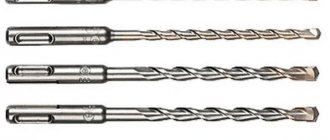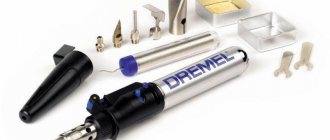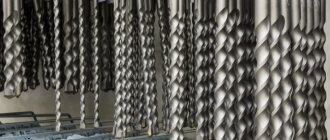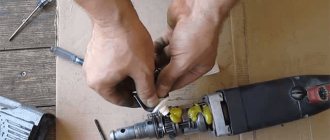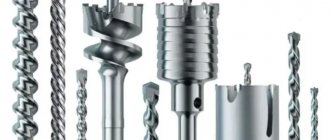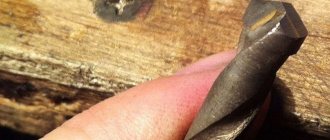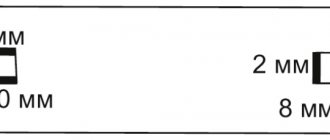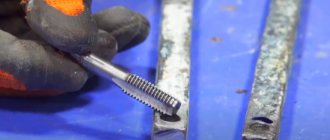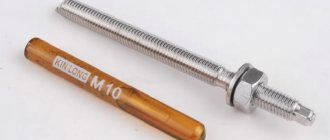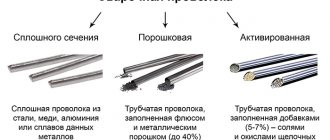During construction or renovation, it is often necessary to drill holes in concrete and stone with a hammer drill. In order for the drilling process to proceed quickly, it is necessary to select the correct concrete drill for the hammer drill. Many people mistakenly think that they can make holes in such material with simple drills. But in fact, during the drilling process, ordinary consumables quickly bend and become dull. This article will discuss the criteria for choosing a drill for a hammer drill. To make it easier to understand, the most popular blastholes from well-known world brands will be listed today.
Types of boreholes
Drill and drill: what is the difference
A drill differs from a drill in that it drills holes through impact-rotational movements. Thanks to this, it is possible to make deep holes (up to 1000 mm) in high-strength structures, which are extremely problematic and often impossible to drill with conventional drills.
True, in the process of such drilling it is often necessary to make reciprocating movements to extract dust from the hole being made. The hole tip is generally equipped with a crown (most often consisting of several cutting segments), which significantly increases its service life.
Important! The most important thing is that the drill does not bite while drilling concrete, otherwise it will break or jam. To extract a hole, some types of hammer drills provide reverse operation. It is also necessary to regularly lubricate the shank so that it wears less.
The drill differs from the drill and has a shank (the part fixed in the chuck). The drill is mainly fixed by movable cams. A special cartridge with locking balls is provided for drill holes. Today, drills with a chiselling function are sold on the market, but they are ineffective in working with hard materials.
SDS Plus Size Chart
How to remove a jammed drill bit from a hammer drill
There are several simple ways to remove a drill bit stuck in it from a hammer drill chuck.
- The free part of the drill, which is stuck in the hammer drill chuck, must be clamped in a vice, and then gently tapped on the cams of the clamping mechanism with a hammer, using a wooden spacer.
- If the method described above for removing a stuck drill does not help, then the cartridge can be placed in a container with gasoline, and then try to remove the drill in the usual way.
- If the drill is jammed in a key-type chuck, you should turn the key of such a mechanism counterclockwise, which will free the tool. If necessary, you can drop machine oil into the key type chuck in which the drill is stuck.
- — To remove a drill that is jammed in the keyless chuck, you can try to loosen the clamp of the fastening mechanism with gentle blows made counterclockwise.
- The last option for freeing a drill that is jammed in a hammer drill chuck is to completely disassemble the fastening mechanism.
Types of concrete drills for rotary hammers
They differ in some important parameters, which are discussed in detail below.
Shank size
There are 5 types:
- SDS - shank with a diameter of up to 10 mm with two grooves.
- SDS plus is the most common size used in household hammer drills. It is characterized by a diameter of no more than 25 mm. There are four grooves for fixing it.
- SDS-max - shank with a diameter of up to 80 mm, used in industrial units. For fixation, it uses three open and two closed grooves.
- SDS-top is an intermediate shank size with a diameter of 16-25 mm, used in some BOSCH power tools. It has 4 grooves for good fixation.
- SDS-quick is a hex shank with a diameter of 4-10 mm, designed for Bosch Uneo/Uneo Maxx rotary hammers. It uses dowels for fixation.
Diameter and length
These are the most important dimensions of the drill, so you should definitely pay attention to them during selection and purchase.
- Diameter. Depends on the length and type of shank - for example, the maximum permissible hole Ø SDS max is no more than 50 mm. It is expressed as an even number.
- Length. The maximum drill length for a rotary hammer is 1000 mm, and the minimum is 100 mm. In production, the most popular drills are Ø 18, 20, 22, 24, 28 and 32. The drilling procedure does not allow the use of longer holes - it is impossible to drill holes with them.
The length of the drill depends on its diameter. These characteristics must be balanced so that deep holes can be drilled efficiently and safely.
The article contains tables showing the length and diameter of drills produced today.
Size Chart SDS Max
It should be noted that the longest drill for rotary hammers in accordance with the latest table is 1320 mm.
Resource (durability)
Experienced installers drill a large number of holes in various structures every day, so the working surface of the hole quickly wears out and its productivity is lost. The durability of a concrete drill for a hammer drill mainly depends on the metal used in its production.
In particular, much depends on the quality of the soldered crown, which is responsible for the main function of the drill (destruction of solid material). If necessary, you can use a drill to drill holes in wood products.
Attention! When choosing a drill hole, you need to take into account its main performance characteristics so that you do not have to subsequently purchase a new one and spend additional money.
Possible problems
A common problem is the drill bit jamming in the equipment chuck. To extract it, you should choose one of several convenient methods:
- the free end of the drill is clamped in a vice and lightly tapped with a hammer with a rubber gasket on parts of the clamping mechanism;
- The hammer drill chuck is placed in a bowl of gasoline and the drill is subsequently removed;
- if a jam occurs in a key-type clamping mechanism, you need to turn the key counterclockwise or add a drop of machine oil;
- a stuck drill in a quick-release chuck is removed by tapping parts of the chuck counterclockwise;
- Complete disassembly of the equipment is possible if none of the methods help.
To learn how to clamp regular drills into a hammer drill, see the following video.
The best drill bits for a concrete hammer drill: rating
Listed below are the most popular drill bits for household and industrial hammer drills today. Thanks to this rating, you can choose effective and durable blast holes for them.
DeWALT EXTREME 2 DT7935B-QZ
Set of 10 drills (USA) in a convenient case with a latch. The drills have an SDS-plus shank, a diameter of 5-12 mm and a length of 110-160 mm. They are designed to work with stone, concrete and brick. Capable of working flawlessly for a long time with proper care.
Intended for household use. It is worth noting that this set is inexpensive.
Set DeWALT EXTREME 2 DT7935B-QZ
BOSCH 3.5×50/110 mm
The drills are distinguished by high quality workmanship and durability. This drill with an SDS+ shank allows you to quickly carry out construction and repair work in a house or apartment.
The cutting segments of the drill bit are made of high quality, so it allows you to make holes in stone, brick and concrete without any problems.
BOSCH 3.5×50 – 110 mm
Granite 425100 25/1000 mm
Has an SDS-plus shank. It uses four cutting segments and a double spiral for high-quality dust removal. It is made of high-alloy steel, and is subjected to hardening. Thanks to this, the service life of the product is significantly increased.
For reference! Due to high demand, it is difficult to find on the domestic market.
Granite 425100 25/1000 mm
Makita D-00050 /100 mm
This drill is designed for household power tools with SDS-plus chucks. It uses two carbide cutting edges, so the process of drilling the material is more uniform and faster.
The drill tip is well centered, due to this, drilling takes place exactly in the given direction. Thanks to the use of this tool, vibration is practically not felt during drilling.
Makita D-00050 −100 mm
Granite Quadro-X 845570 45/570 mm
Designed for industrial hammer drills with SDS-max chucks. Its cutting bit consists of four cutting parts made of high-alloy metal. Thanks to this, the drill has increased wear resistance.
It has a double spiral, due to which the destroyed material is quickly discharged out.
Granite Quadro-X0 mm
Thanks to this rating, the reader will no longer have the question of which drill bits are best for rotary hammers today.
With the help of this article, you can quickly select the optimal drill for a household and industrial hammer drill, and then at any time make the required number of holes in walls, floor slabs and other structural elements of buildings and structures. The most important thing in the drilling process is to adhere to drilling technology and safety precautions so as not to get injured or break the tool used in the work.
Useful tips
Some tips for handling drills from professionals:
- It is not advisable to use large-diameter drills for drilling bricks, since this can lead to its splitting, but if this is still necessary, then it is better to gradually increase the diameter;
- It is better to drill stone and ceramics using a drill setting, gradually adding water;
- When drilling reinforced concrete when sticking into reinforcement, it is necessary to change the drill to a drill of the appropriate diameter for metal and, having overcome this obstacle, continue to work with the drill;
- If the cutting edge is slightly worn down, you can sharpen it again, but it will not be possible to do this correctly right away, since this requires some experience;
- To the question “what are the best metal drills,” one can only say that good products require the use of expensive materials and technologies, so a priori they cannot be cheap. Read about step drills here.
Follow these tips and don't make mistakes!
It is not water that wears away stones
The main working part of any drill is the tip. It must be made of durable material that can withstand work under conditions of enormous loads and overheating, because its main task is to literally break the strong structure of the stone.
The vast majority of drills are tipped with an alloy of carbon-rich tungsten and cobalt. This alloy is popularly called Pobedit alloy. It has very high strength values and is capable of making holes in such durable rocks as granite and marble.
By the way, the same material is used to make tank armor-piercing shells.
Stronger and more durable cutting tool edges are made from synthetic diamond. This super-hard material guarantees trouble-free drilling into granite and reinforced concrete of the highest strength. However, the cost of such instruments will be higher than their Pobedit analogues.
How to choose?
Hammer drills are divided into models with different coatings.
- Oxide. The exterior of the drills is painted black - this is the cheapest coating. The film covering the drill protects the hammer drill chuck from overheating and rust, increasing its service life.
- Titanium-aluminum nitride coating. Allows you to increase the service life of drills by 5 times. Reliable and high quality drills.
- Ceramic coating. These drills are not made of pure ceramics, but of titanium nitrides. The disadvantage of this coating is the impossibility of sharpening the nozzle.
- Carbonitride titanium coating. It also increases the service life of nozzles and is highly durable.
- Diamond spraying is intended for working with stone and porcelain stoneware surfaces.
When purchasing, you should pay special attention to some characteristics
- Drill shank type. It is imperative to take into account the type of shank, otherwise the drill will not be securely fixed in the chuck, which will lead to equipment failure. To find out the type of cartridge, you can use the instructions included with the tool. The shanks of hammer drills are marked SDS-max and SDS-plus and are made in a more complex shape than drill bits for drills.
- Manufacturer. Many popular companies produce a whole range of tools with different pricing policies. Most often in stores you can find high-quality products for household needs at quite affordable prices, but professional tools are difficult to find.
- Drill length The length of the total or only the working surface can be indicated.
- Head diameter. To work with various materials, drills with the appropriate diameter are used. A hole smaller than the desired size will be quite difficult to enlarge using a narrow drill. In addition, this will lead to poor-quality work, which will affect the degree of fixation of the fasteners of the installed mechanism.
- Grooves. The grooves of drills are different: semicircular, with protrusions and beveled. The first are intended for household work that does not require high precision. The last two types are used in large enterprises due to their ability to quickly drain.
- Carbide groove. Smooth and smooth surfaces of drills are designed for working with soft materials or the external surfaces of bolts and screws. On drills, the geometric surface of the drill tip is sharper and comes in complex shapes - this is due to the impact mode of operation.
Types of nozzles
The nozzles differ from each other in many ways. The most distinctive parameter is the shape of the working part. Drills are:
- Screw. These are the most popular drills that are usually used for work on the farm. The length of the instrument may vary, but as a rule, it is 27.5 centimeters. They can form holes in wood and other surfaces. The diameter of the spiral can vary from 0.1 millimeters to 7 centimeters.
- A feather drill resembles a feather in shape and is used to drill a large and deep hole. The cutting edge of the tool resembles a spatula in appearance. The drill can be solid, but can also be fixed using a boring bar or a specialized attachment.
- Single-sided cutting drill. It is used for drilling holes with particularly precise dimensions. The nozzle allows you to cut the surface on one side only. It has a special supporting surface, and the cutting edges are located on one side of the central axis.
- For deep drilling. This is an excellent option if the hole depth must exceed 5 drill diameters. The nozzle has two specialized channels through which the cooling emulsion is passed. They can be located both inside the drill and outside.
For drills whose diameter exceeds 0.8 millimeters, welding is used. The main part is made of high-speed steel, and a carbon type of material is used for the shank. A nozzle with carbide inserts is used for drilling holes in very fragile objects and surfaces. Its structure is distinguished by the presence of certain grooves.
